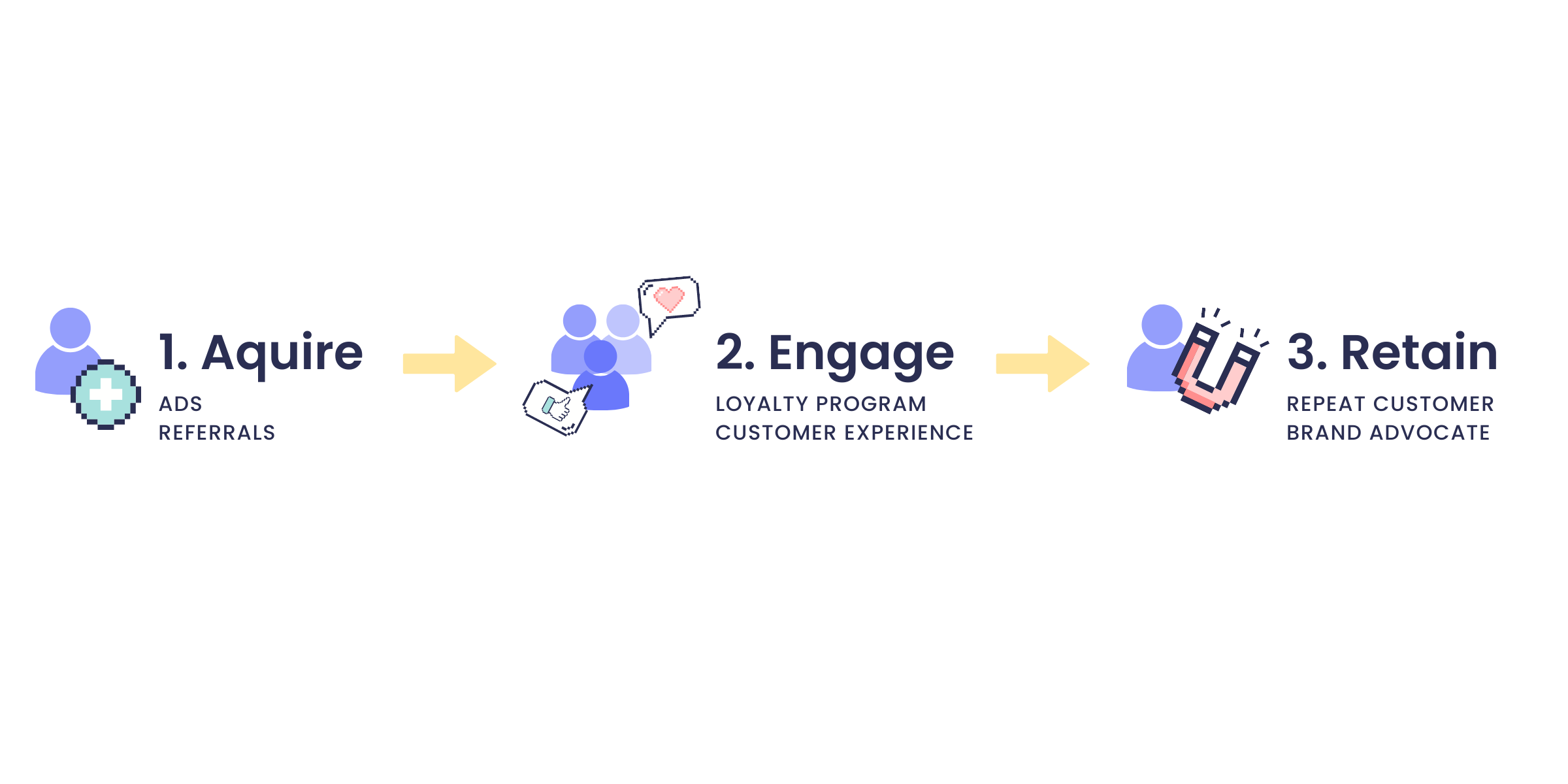Editor’s Note: This post was originally published on December 29, 2016 and was updated for accuracy and comprehensiveness on April 22, 2024.
Acquiring customers to your ecommerce site is part strategy and part science. Acquiring customers is a process that never stops, involves experimenting with different tools and channels, and requires some creativity.
Acquisition and retention go hand in hand, working together to ensure your customer base expands while your existing customer base converts into paying repeat customers. The best ROI and most straightforward way to optimize your existing customers is through your loyalty and rewards program. Optimizing it to become an acquisition tool.
- Optimize your current customer base through loyalty and rewards.
- Many customers will actively seek out businesses that offer a loyalty program.
- Rewarding for referrals opens up peer-to-peer marketing, the most trusted acquisition channel.
- Experimenting with your loyalty and rewards program offers an opportunity to build an engaged brand community of customers who will promote your brand.
- Acquisition and retention go hand in hand, working together to ensure your customer base sustainably expands.
What is customer acquisition in ecommerce?
Customer acquisition in ecommerce is the process of reaching prospective customers through different methods and channels and engaging with them so they convert. Popular customer acquisition channels include email marketing, SMS, social media, ecommerce websites, paid ads, blogs, retail locations, and more.
Klaviyo states, “Typically [customer acquisition] involves various marketing and sales strategies to reach potential customers, generate interest in the offerings, and ultimately convert them into paying customers.
How a loyalty program helps your acquisition efforts
Acquiring that first-time customer is great! When a customer returns for a second purchase, a couple of notable things happen. Customers will reconvert on future visits, spend more per visit, and become your brand advocates by sharing your brand—even more so if there is an incentive via referrals.
Using loyalty as an acquisition tool helps you to build a customer base that shops with you over a competitor. According to loyalty in ecommerce stats, 35% of an ecomm store’s revenue is generated by the top 5% of customers. This means that a core customer base will drive a significant amount of revenue.

Tip 1: Have a loyalty program
Depending on the type of shopper that typically browses your store, a loyalty program can help convince them to make that initial purchase. Many customers will actively seek out businesses that offer loyalty programs, especially if it’s a place they frequent. A loyalty program will drive customers to spend more. According to our 2023 State of Ecommerce Loyalty Report, shoppers using Smile.io rewards coupons (redeeming a reward) have a 16.5% higher AOV than those using non-Smile coupons.
While all shoppers can get value from a loyalty program, two types in particular actively seek them out—experience seekers and value-driven decision-makers.
An experience seeker is a shopper interested in your brand and wants to be a part of an overall community.
When these shoppers invest their time and money in more than just orders, they form a relationship with your brand and get locked in for the long haul These shoppers are especially drawn to programs that have a VIP tier component to them.
The second type of shopper attracted to a loyalty program is the value-driven shopper, which is not to be confused with a price-sensitive shopper. While price-sensitive shoppers are looking for the lowest price possible, value-driven customers are looking to maximize the total value of their purchase, aka the highest quality of the product relative to the purchase price.
A loyalty program allows them to buy what they want while gaining points to help with future purchases. Points help them maximize value because of the rewards they are earning, which translates to discounts, free shipping, or free products.
Take skincare brand Dr. Sam’s, who offers a VIP-tiered loyalty program that rewards customers up to 7 points for every £1 spent on its highest tier. Customers can redeem for discounts, have early access to products, and be invited to exclusive events. Dr. Sam’s makes its loyalty and rewards program an experience new and returning customers can participate in and see immense value in.

Tip 2: Get referrals
Your community is your strongest source of recommendations, making referrals that much more valuable in an ecommerce setting. The more trustworthy the person sharing the referral, the more trust a potential customer will place in the brand, especially as a first-time customer. It’s estimated that “92% of consumers around the world say they trust recommendations from friends and family, above all other forms of advertising.”
Rewarding points for referrals opens up peer-to-peer marketing, the most trusted acquisition channel. A referral program has to be rewarding to both the person making a referral and the person receiving a referral. By giving your customers points or a cash-back incentive to refer their friends, you create a trusted communication channel with new customers by leveraging the ones you already have. We recommend also rewarding the friend to make it a win-win-win referral situation.
Clothing brand Onward Reserve, has a great loyalty and rewards program that incorporates a points, VIP, and referral program. Its referral program lets both customers know what they are getting when they refer or receive a referral—a $20 off coupon for both parties. At a glance, you know exactly what you are getting and where to sign up. This increases the desire to participate and engage with other areas of the brand.


Tip 3: Use your rewards program as an event-based marketing tool
With various social channels, viral videos, and increased competition in ecommerce, making your brand cut through the noise seems extremely difficult. But it doesn’t have to.
The brands you can’t help but talk about are the ones you see the most often. This means that the more often your brand engages potential customers, the more likely they are to remember it and prefer it. For the past decade, that’s meant funneling as much as possible into digital ads or getting as many eyeballs on your brand as your budget will allow.

Simply spending money on ads won’t get you the high-value exposure you expect. Experimenting with your loyalty and rewards program will offer an opportunity to build a brand community of customers who will engage and talk about your brand. Offer experiential rewards when someone hits a certain tier in your VIP Program. These rewards can be limited-time products, exclusive product access, or VIP-only events. It’s also a great idea to experiment with time-based bonus points campaigns.
For example, let's say our most popular product is shiny lip gloss, and we are adding the grape flavor to our lineup. But for July, it will be available exclusively for 500 points. Then, we will entirely drop for purchase in September. This will only work to hype up highly anticipated items. Or let’s say for our brand anniversary weekend; we want to offer double the points for every order. This will build up a points balance for customers to redeem on their next order, giving them a reason to come back.

Retention and acquisition rolled into one
Acquiring customers for your ecommerce site doesn’t have to be complicated. Acquisition and retention work together to ensure your customer base grows and converts into customers that support your ecommerce brand over a competitor. By focusing your rewards and loyalty program as an acquisition tool, you realize its foundation is a retention strategy.











